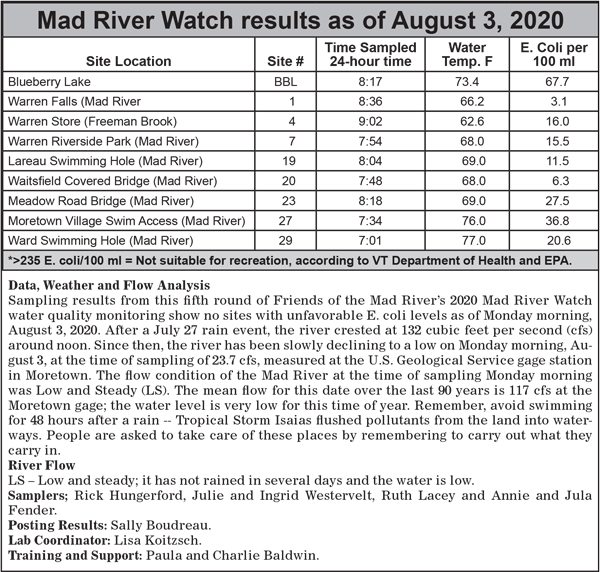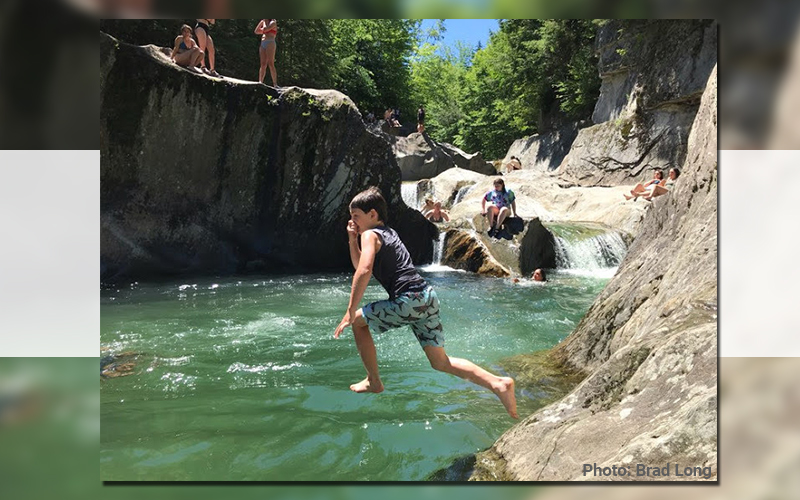By Mary Gow
Just three public swim holes. When Friends of the Mad River (FMR) was founded in 1990, there were three publicly-owned swim holes on the main stem of the Mad River -- the Picnic Area Cascades along Route 100 at the Granville town line, part of Lareau and the Kenneth H. Ward Access in Moretown. Every other one of 15 frequented spots was on private land, including Warren Falls. For a river identified in a Vermont Agency of Natural Resources study as “unquestionably one of the state’s best” in terms of number and quality of swim holes, public access was very limited. Private property owners’ generosity then, as now, was key to much enjoyment of the river.
In FMR’s three decades, publicly-owned and permanently-permitted access areas on the river doubled in number.
Increased access has been a team effort. Along with FMR, Valley towns, the state, Green Mountain National Forest, land trusts, local trail associations, businesses, MRV Rotary, Sugarbush Resort, individual property owners and others worked to provide these expanded recreational opportunities.
VISIONS FOR THE RIVER
One of FMR’s first initiatives was conducting public forums to get broad community input about residents’ visions for the river. A desire for high quality water, swimmable, even drinkable, topped participants’ lists. Another top priority was public access. Opportunities soon arose.
In the mid-1990s, the owner of property surrounding Warren Falls, who had posted the land to discourage trespassing, began plans for development there and listed his acreage for sale for over a million dollars.
FMR advocated for its acquisition by the Green Mountain National Forest. But there were stumbling blocks, including a $60,000 shortfall in funding. FMR helped bring The Conservation Fund into the process, allowing a stepped transition and launched a fundraising campaign.
“People came out of the woodwork to support it,” Kinny Perot, FMR board president recalls. “We had gifts from $10 to $10,000,” enough to meet the goal.

Lareau Swim Hole in the 1990s was public, but complicated. Right next to it sat a state-owned salt shed with stored road material. The 1998 flood made the situation precarious.
“It was deteriorated but still used, and the state planned to rebuild it,” recalls FMR board member Brian Shupe.
The Waitsfield Select Board and Planning Commission and FMR advocated for the state to tear down the shed, relocate the facility and turn the land over to the town. The plan succeeded and was followed by a state grant and community support for site design and landscaping.
Another product of the 1998 flood, Riverside Conservation Area in Warren was created with Federal Emergency Management Agency funds after the loss of homes on the site. FMR worked with the Mad River Path Association and the town of Warren on site layout and coordinated riparian buffer planting after the 1998 and 2011 floods.
In another collaboration, FMR, Mad River Path Association and individual property owners secured a permanent easement allowing access and establishing riparian buffers at the Meadow Road Bridge in Waitsfield.
FMR has partnered and advocated to preserve and enhance swim holes, improving access and also working to maintain healthy riparian buffers for wildlife habitat, clean water and flood resilience. FMR’s Mad River Watch has monitored water quality, educating the public about conditions that pose health risks for swimmers.
GENEROSITY
Acutely aware of property owners’ generosity when allowing use of their lands, FMR has endeavored to educate river users on respecting owners’ property and privacy, including in FMR’s publication “Caring for the River, Caring for the Land.”
“These energies haven’t stopped some beloved swim holes from being ‘loved to death,’” said Corrie Miller, FMR executive director. “Through the years, publicly- and privately-owned swim holes have seen dirty diapers, trash dumping, unsanctioned rock moving and tree cutting. I’m hopeful that the conversation bubbling up this summer about river access and trash at swim holes is an opportunity for our community to bring the spirit we used in securing access to swim holes to new challenges of caring for them, so they can be enjoyed through future decades.”






